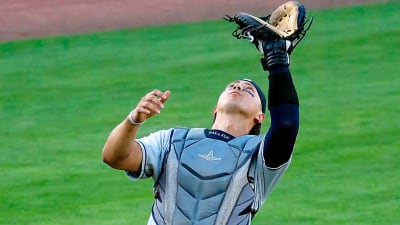
Get a full breakdown of the Anaheim Ducks salary cap situation, including Dom Luszczyszyn’s contract efficiency rankings, bad deals, bright spots, and long-term flexibility.
Anaheim Ducks Salary Cap Situation
The Anaheim Ducks salary cap picture is a study in contrasts. On one hand, Dom Luszczyszyn’s 2025 contract efficiency rankings for The Athletic placed the team 28th in the NHL, dragged down by expensive veteran deals that offer little surplus value. On the other hand, Anaheim also leads the league with over $20 million in cap space and boasts one of the deepest pipelines of players on cost-controlled entry-level contracts. The result is a cap sheet that looks inefficient today, but has clear upside as the Ducks’ young core matures and short-term money falls off the books.
League Ranking (Contract Efficiency): 28th of 32 (The Athletic, Aug. 2025)
Average Positive Value: 36% (2nd-lowest in NHL)
Current Cap Hit: $74.96M
Cap Space (2025–26): $20.5M (highest in NHL)
Notable RFAs: Mason McTavish
Key ELCs: Leo Carlsson, Cutter Gauthier, Pavel Mintyukov, Olen Zellweger, Tristan Luneau
Best and Worst Deals
| Category | Player | Contract | Surplus Value (per Dom’s model) | Grade |
|---|---|---|---|---|
| Best Contract | Lukas Dostal | 5 yrs × $5M AAV | +$17.4M | A |
| Most Efficient Skater | Jackson LaCombe | 1 yr × $0.9M | +$5.3M | A- |
| Worst Contract | Mikael Granlund | 3 yrs × $7M AAV | –$10.6M | D |
| Biggest Swing Factor | Mason McTavish | RFA (Unsigned) | TBD – will shape future efficiency | N/A |
| Veteran Overpay | Jacob Trouba | 1 yr × $8M | –$6.4M | D+ |
Too Much Bad Money on the Books
According to Luszczyszyn’s contract efficiency rankings, the Ducks sit 28th in the league, earning a C grade with only 36 percent of contracts projecting positive value. The culprits are clear. Mikael Granlund’s $7 million deal stands out as one of the league’s least efficient, posting a projected negative surplus of $10.6 million. Ryan Strome, Alex Killorn, and Jacob Trouba are also deep in the red, each graded D or worse under the model.
Yes, Anaheim has been forced to pay a bad-team tax to attract veterans. But as Luszczyszyn notes, that explanation only goes so far. Taking on the full freight of Trouba’s $8 million deal without additional assets is exactly the type of move that drags down a cap sheet. The result is a roster that currently ranks among the least efficient in terms of dollars spent.
Bright Spots: Dostal and the ELC Wave
However, the model does not paint the Ducks’ situation as hopeless. On the contrary, it highlights a few crucial bright spots. Lukas Dostal’s new five-year, $5 million AAV extension is graded A, generating an eye-popping $17.4 million in surplus value. In a notoriously volatile position, that is a rare stabilizer.
Jackson LaCombe also rates as an excellent short-term bargain, with nearly $5.3 million in surplus value on a league-minimum deal. Depth forward Ryan Poehling earns a solid B+ grade. Most importantly, Anaheim’s core of Leo Carlsson, Cutter Gauthier, Pavel Mintyukov, Olen Zellweger, and Tristan Luneau all sit on entry-level contracts. That built-in efficiency does not show up as surplus value in Dom’s model yet, but it is a critical factor for the Ducks’ trajectory.
League Leaders in Cap Space
Meanwhile, Anaheim’s $20.5 million in cap space is the highest in the NHL heading into 2025–26. That financial cushion offers multiple strategic options. Pat Verbeek can afford to absorb additional short-term contracts for draft capital, or he can weaponize space to chase impact free agents when the rebuild accelerates.
Timing also works in Anaheim’s favour. Trouba, Gudas, Strome, and Kreider will all come off the books within the next two years. As those contracts expire, the Ducks will be transitioning into contention mode with Carlsson, McTavish, and Gauthier entering their prime. The current inefficiency is painful, but it also should be short-lived.
Looking Ahead: McTavish and Verbeek’s Bridge Philosophy
The single biggest swing factor is Mason McTavish’s next contract. Verbeek has shown a preference for bridge deals with young players, buying time before long-term commitments. In a rising cap environment, however, that strategy carries risk. If McTavish breaks out as expected, Anaheim could be forced to pay market price later and miss out on surplus value today.
Still, with Dostal secured and Carlsson on an ELC, the Ducks are insulated from immediate cap stress. The combination of cap space, expiring veteran contracts, and a deep ELC pool suggests that Anaheim’s 28th-place efficiency ranking could climb quickly. As Luszczyszyn himself noted, “it wouldn’t be a shock to see a lot of deals look better next summer.”
Closing Thoughts
Right now, the verdict is clear: the Anaheim Ducks’ contract sheet is one of the least efficient in the league. Too much money is tied up in Granlund, Killorn, Strome, and Trouba, dragging the team down to a C grade. Yet the long-term picture is not nearly as bleak. With the league’s most cap space, an elite efficiency anchor in Lukas Dostal, and a wave of ELC-driven talent, Anaheim has the tools to flip the script within the next two years.
For now, the Ducks are near the bottom of the rankings. But in a rising-cap NHL, they have positioned themselves to climb quickly once their prospects mature and the dead money clears.
More must-reads:
- Nazem Kadri hopeful to make Canadian Olympic team despite camp snub
- Jayden Daniels reveals 'main focus' for improving after stellar rookie season
- The 'Most multi-HR games by MLB team' quiz
Breaking News
Trending News
Customize Your Newsletter
 +
+
Get the latest news and rumors, customized to your favorite sports and teams. Emailed daily. Always free!








